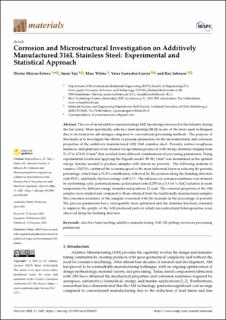| dc.contributor.author | Maicas Esteve, Héctor | |
| dc.contributor.author | Taji, Iman | |
| dc.contributor.author | Wilms, Marc | |
| dc.contributor.author | Gonzalez-Garcia, Yaiza | |
| dc.contributor.author | Johnsen, Roy | |
| dc.date.accessioned | 2023-02-03T10:13:55Z | |
| dc.date.available | 2023-02-03T10:13:55Z | |
| dc.date.created | 2022-05-02T08:26:33Z | |
| dc.date.issued | 2022 | |
| dc.identifier.citation | Materials. 2022, 15 (4), . | en_US |
| dc.identifier.issn | 1996-1944 | |
| dc.identifier.uri | https://hdl.handle.net/11250/3048224 | |
| dc.description.abstract | The use of metal additive manufacturing (AM) has strongly increased in the industry during the last years. More specifically, selective laser melting (SLM) is one of the most used techniques due to its numerous advantages compared to conventional processing methods. The purpose of this study is to investigate the effects of process parameters on the microstructural and corrosion properties of the additively manufactured AISI 316L stainless steel. Porosity, surface roughness, hardness, and grain size were studied for specimens produced with energy densities ranging from 51.17 to 173.91 J/mm3 that resulted from different combinations of processing parameters. Using experimental results and applying the Taguchi model, 99.38 J/mm3 was determined as the optimal energy density needed to produce samples with almost no porosity. The following analysis of variance ANOVA confirmed the scanning speed as the most influential factor in reducing the porosity percentage, which had a 74.9% contribution, followed by the position along the building direction with 22.8%, and finally, the laser energy with 2.3%. The influence on corrosion resistance was obtained by performing cyclic potentiodynamic polarization tests (CPP) in a 3.5 wt % NaCl solution at room temperature for different energy densities and positions (Z axis). The corrosion properties of the AM samples were studied and compared to those obtained from the traditionally manufactured samples. The corrosion resistance of the samples worsened with the increase in the percentage of porosity. The process parameters have consequently been optimized and the database has been extended to improve the quality of the AM-produced parts in which microstructural heterogeneities were observed along the building direction. | en_US |
| dc.language.iso | eng | en_US |
| dc.publisher | MDPI | en_US |
| dc.rights | Navngivelse 4.0 Internasjonal | * |
| dc.rights.uri | http://creativecommons.org/licenses/by/4.0/deed.no | * |
| dc.title | Corrosion and Microstructural Investigation on Additively Manufactured 316L Stainless Steel: Experimental and Statistical Approach | en_US |
| dc.title.alternative | Corrosion and Microstructural Investigation on Additively Manufactured 316L Stainless Steel: Experimental and Statistical Approach | en_US |
| dc.type | Peer reviewed | en_US |
| dc.type | Journal article | en_US |
| dc.description.version | publishedVersion | en_US |
| dc.source.pagenumber | 23 | en_US |
| dc.source.volume | 15 | en_US |
| dc.source.journal | Materials | en_US |
| dc.source.issue | 4 | en_US |
| dc.identifier.doi | 10.3390/ma15041605 | |
| dc.identifier.cristin | 2020481 | |
| cristin.ispublished | true | |
| cristin.fulltext | original | |
| cristin.qualitycode | 1 | |

